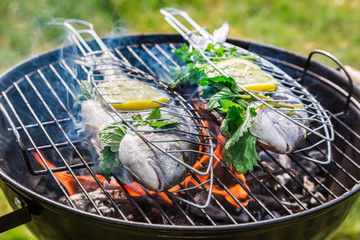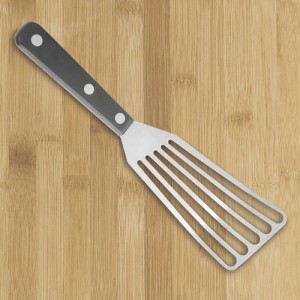How to Grill Fish

Grilled Fish
How to Grill Fish
Cooking fish can be difficult. It’s not like meat; if you grill a strip steak, and forget about it, it’s still going to be edible- not so with fish. If seafood is overcooked, even by a few minutes, it can become dry, tasteless, and unpalatable. Here are a few suggestions for cooking fish so that it turns out succulent, flavorful, and delicious.
Before you begin cooking any type of fish you, will need to purchase a fish spatula; here’s what they look like:
Spring and summer are almost here, and it’s time to take advantage of the beautiful weather, and fire up the grill. There’s nothing better than eating a piece of freshly grilled fish; the mesquite flavor carries over, and brings out the natural sweetness of the fish.
Prior to grilling a piece of fresh fish, make sure that the grill you are using is clean from debris. The surface of the grill should also be seasoned. Simply dab a clean cloth in some vegetable or olive oil and run it across the cooking surface of your grill. Place a small amount of olive oil or butter on the fish, then season with salt and pepper. Once the grill is hot, and the charcoal is gray, or the temperature of the grill is 350 degrees, place the piece of fish on the center of the grill, presentation side down. Depending on the size and thickness of the fish, cooking times will vary- a thick cut of sea bass is clearly going to take longer to grill than a thin piece of tilapia.
Here is how to tell if your fish is getting done:
After two to three minutes of cooking, the edges of the fillet will start to look opaque; at this point it is time to turn the fish. Gently, and with finesse, place the fish spatula under the fillet, and gently flip it on the opposite side. Do not move the fish with your spatula more than once after it has started to cook! Continually moving the fish around with your spatula will cause the flesh to tear; thus ultimately affecting the presentation.
There are two ways to tell if your fish is cooked- first, by temperature. Most fish should be cooked to an internal temperature of 125 degrees. Although not all fish requires this specific temperature, it will suffice for most species. The downside to using a thermometer to test doneness, is piercing the fish will damage the flesh, and may release juices that help maintain moisture.
The best way to tell if your seafood is properly cooked is by touch. You can either touch the sides, or the top of the fish to determine doneness. If you are cooking a piece of salmon, use your middle finger, and thumb to pinch the sides of the fillet. There should be some resistance, and it should also feel soft to the touch. If you pinch the sides of the dish and it feels firm, your fish is overcooked.
Don’t expect to master this technique right away- it takes many fillets to develop the touch that is required to determine if your fish is cooked properly. In the beginning, you may need to pinch the sides of your fish, then cut it in half and look inside. The middle of the fish should look slightly underdone- once the fish is taken off the grill it will continue to cook for a few minutes.
A few key points to remember:
Buy a fish spatula.
Always make sure to season your seafood with salt and pepper. If grilling, place a small amount of oil or butter on the outside of the fish before cooking; this will help prevent sticking to the cooking surface.
Do not touch the fish with your spatula more than once; when flipping your fish.
Take your time when developing your touch to determine doneness; it won’t come right away.
Although cooking fish can be more difficult than cooking chicken, or meat, it can be mastered. Take some time to learn about your ingredients, and cooking techniques- success will surely follow!
Chef Chuck Kerber
Cooksandeats.com
chuck@cooksandeats.com







 in <b>/var/www/vhosts/cooksandeats.com/httpdocs/wp-content/themes/CooksandEats/sidebar.php</b> on line <b>1</b><br />
/wp-content/themes/CooksandEats/images/side-logo.png)



 in <b>/var/www/vhosts/cooksandeats.com/httpdocs/wp-content/themes/CooksandEats/footer.php</b> on line <b>13</b><br />
/wp-content/themes/CooksandEats/images/back-to-top.png)